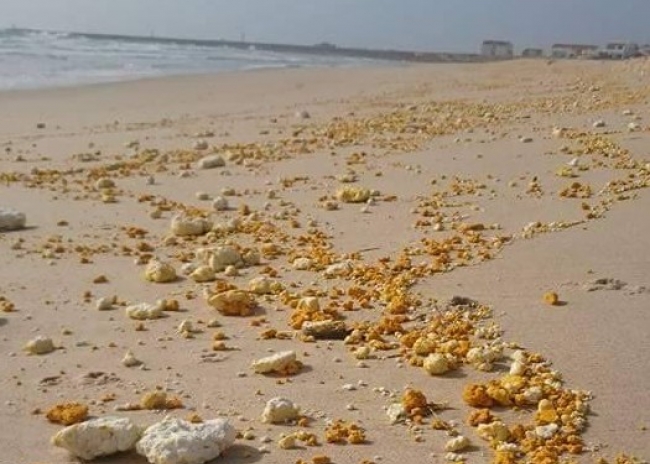 An area of localised pollution on the beaches of the Ria Formosa island of Culatra has turned into a 14 kilometre long headache.
An area of localised pollution on the beaches of the Ria Formosa island of Culatra has turned into a 14 kilometre long headache.
A carpet of yellowing globs of palm oil has made the beaches un-useable and the Culatra-based organisation SOS Ria Formosa has another fight on its hands and is calling for volunteers this weekend to help clean up the mess.
The concern at first was that the yellow and white foam-like material was toxic, or at least hydrocarbon-based, but the Captain of the Port of Olhão later confirmed that the substance was in fact palm oil, probably expelled when, sometime before January 4th, a passing freighter illegally washed out its storage tanks.
The captain of the Port of Faro said that, after finding who is responsible, it will still be necessary to find out whether it was a deliberate or an accidental event, although in any case, the law has been broken and someone is responsible.
While the authorities, including the Southern Maritime Department, the Portuguese Environment Agency, the Institute for the Conservation of Nature and Forests, Civil Defence and the local councils ponder how best to coodinate the clean-up operation, the islanders already have called for volunteers to help them bag up the greasy mess, starting this Saturday.
The captain of the Port of Olhão, Nunes Ferreira, said the cleaning work is being done with the help of 40 personnel from the National Maritime Authority and the Navy and noted that it is "a bit complicated to remove and has to be collected with some care."
"We are working with the other entities, such as the municipal councils of Faro and Olhão, the Ria Formosa Natural Park and the Ria Formosa Islands residents associations to find 150 volunteers for this Saturday, and another 150 on Sunday," said Commander Nunes Ferreira.
Faro Port captain, Cortes Lopes, said the cleanup is complex and that it will take a long time.
The port authority asks people to go to the Lighthouse on Culatra on Saturday to be issued with gloves and bags but the authority admits that a full analysis has not yet been concluded so it cannot 100% confirm whether the pollution is totally safe for the public to handle.
The Navy is involved as well and is to try and find the source of the palm oil slick which has ended up on some of the most pristine beaches in Europe.
The irony here is that the entities invloved in this high-profile clean up, relying on exposing volunteers to unknown levels of toxicity, are the same ones that 'day in, day out' ignore the raw sewage being expelled into the Ria Formosa from the mainland, this being a far larger and ever-present threat to water and shellfish quality.

Below: morning volunteer clean-up shift, Saturday 7th January, 2017.






















